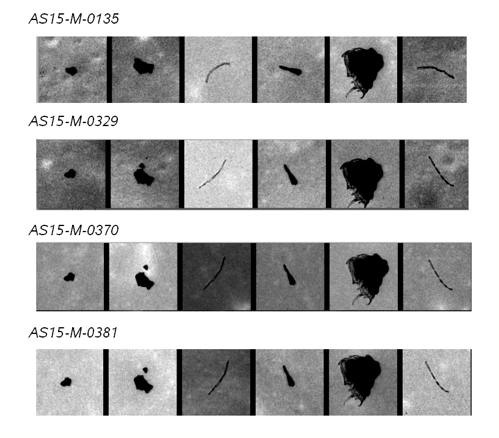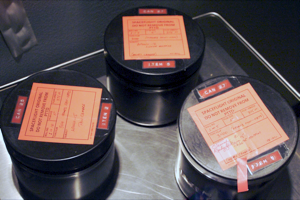
| Project Home | About the Scans | Browse Gallery | Image Map | Support Data | Resources | Ephemeris |
See the first featured image for further explanation about the Apollo Lunar Mapping Cameras.
Procedure for scanning the film
All the original Apollo film can be found in the Film Archive (Building 8) at Johnson Space Center (JSC). Due to the importance in preserving these films, the original film is not allowed to leave the building.
The film is stored in a freezer (0° F), which is located in a large refrigerator that is maintained at 55° F. The staff at JSC has a rigorous procedure for removing film from the freezer for scanning or making copies.
-
The sealed film canister is transferred from the freezer to the refrigerator where it is allowed to equilibrate for 24 hours.
-
The sealed canister is then removed from the refrigerator and placed in a room temperature environment and allowed to equilibrate for an additional 24 hours.
-
The film is then removed from the canister, hand cleaned (see below) and scanned.
The film is placed back in the canister, sealed, and then placed back in the cold vault.
|
|
|
The Scans
An important aspect of this project is the effort to record as much of the information content of the film as possible. Scans are acquired with a Leica DSW700 photogrammetric scanner allowing for very high geometric and radiometric fidelity. In addition, the films are scanned at very high spatial resolutions (up to 200 pixels/mm) and an extended bit depth (14-bit A/D) in order to insure that as much of the information content of the film is preserved.
First, all the 35-mm photographs were scanned (about 620 frames). Next, the Metric camera's 10,153 frames (BW) and the 4,612 frames from the Panoramic camera (BW) were scanned. We are now scanning the ~20,000 Hasselblad photographs (BW and color). A table of the file sizes of the scans is summarized below.
Camera |
Film Size (mm) |
Resolution (pix/mm) |
Image Size (pix) |
File Size (MB) |
Hass. Color |
64x64 |
100 |
6,400 x 6,400 |
234 |
Hass. B&W |
64x64 |
200 |
12,800 x 12,800 |
313 |
Metric |
120x120 |
200 |
25K x 25K |
1200 |
Panoramic |
127x1219 |
200 |
25K x 240K |
6,500 * |
35-mm |
24x18 |
120 |
3070 x 2044 |
18 |
* A Panoramic image consists of 8 tiles, each with an image size of 25K X 40K pixels and an approximate file size of 1.9GB. |
Film Cleaning Details
The goal of this project is to preserve the Apollo flight film products - in both the digital and physical formats - for generations to come. These films have been in deep storage for almost three decades; prior to that, they were exposed to the space environment, developed, and occasionally used for research activities. Consequently, the preserved film stocks have, in some cases, acquired foreign material which must be removed. Prior to scanning, each film roll is therefore gently, non-abrasively cleaned using exacting procedures set forth by the NASA-JSC curatorial staff. Absolutely no abrasive techniques are used in the cleaning of these films to preclude the possibility of damage to these priceless historical treasures. As a consequence of this precaution, the cleaning process only removes debris that is loosely adhered to the film stock (e.g. dust and lint) but any strongly adhered debris are simply left on the film.
Scanning Details
Each metric frame is scanned using a Leica DSW 700 photogrammetric scanner, which obtains a 200 pix/mm (pixel size: 5 microns) spatial resolution and 14-bit A/D (16,384 shades of grey). The DSW 700 was modified from the original 12-bit A/D to a 14-bit A/D because the Moon is a very high-contrast target and the original film is capable of capturing a very wide range of grey scale variation. The combination of small pixels (5 micron) and the 14-bit gray scale results in a very detailed scan and, of course, very large raw scan files. Metric film scans are approximately 1.3 GB each and panoramic film tiles are 1.9GB each and require eight tiles for a single panoramic image.
Image Processing Notes
The scans of the Apollo flight films are processed using a standard set of procedures. First, the unexposed portions of the film along the edges of a scanned frame are cropped, and the frame is straightened. Second, the background is removed from all of the scans, by assuming that the average DN values of the unexposed regions at the edge of each raw scanned image represent the background (i.e., film base and fog). Third, a flatfield correction (derived from the actual image data) removes vignetting to the first order. Fourth, the reseau patterns (the small crosses visible on Apollo images published elsewhere) are removed from the images. Fifth, a logarithmic histogram transformation is applied to the image. This is necessary because of the logarithmic response of film, which makes the raw scans appear very contrasty. Since photographic paper also has a logarithmic response and reverses the films response, conventional paper prints have a natural contrast range. The logarithmic histogram correction applied to the scanned images therefore produces a virtual print that simulates the natural contrast of a conventional paper print. Sixth, since the uncompressed images produced by the initial scanning process result in extremely large images, the scale is reduced by a factor corresponding to the square root of 2, which serves to reduce the image size by 50%, and the images are converted from 16-bit to 8-bit. The original, unprocessed raw scans are also provided on this website in full-resolution 16-bit TIFF format. More details about the file formats are provided in a following section.
Blemish Artifacts
Prior to exposure, the film in the Apollo mapping camera system (a schematic of which is reproduced below) was held by pressure against a glass plate containing the reseau marks.
Figure 1. A schematic diagram of the metric mapping system. Note glass plate in lower left of the diagram. (Reproduced from NASA SP-362, Figure 6)
Subsequent analysis during image reprocessing revealed that foreign debris was present in the optical path of the camera system, and can be seen in the photographic exposures. Selected examples of blemish features of this type are shown in Figure 2. A movie showing blemish movement can be seen here. While the image processing steps undertaken as part of this effort may have removed some of these blemish features, users should be aware that blemish features exist in many of the images.

Figure 2. Examples of consistent blemish features in sequential metric frames from the Apollo 15 mission. Note how the position and orientation of these blemish features change slightly from frame to frame (ASU).
A bright, lightning-like feature is found on a small number of images. This type of blemish is the result of a spark caused by static discharge. As the film moves through the camera system (see Figure 1), static charge is built up and, when discharged, an image of the spark is captured by the film. These features typically originate at the edge of the image and branch inward. The sizes vary greatly, from small, discrete bright spots (Figure 3A), to encompassing an entire half of a Metric image (Figure 3B). In the affected images, the spark may take on many different forms, several examples are given below. This list is by no means inclusive of all the "spark" images.

Figure 3. Examples of how static discharge appears on the processed images from the Apollo 17 mission. These examples are from the smallest down-sampled png products: A) AS17-M-1364, B) AS17-M-1521, C) AS17-M-1379, D) AS17-M-1382.
Dark Images
Over 2000 Metric frames do not have illuminated Moon in the field-of-view (see Apollo Over the Moon for details). These include images taken prior to launch, during the journey between the Earth and Moon, on the night-side of the Moon, and while the camera was retracted after leaving the Moon's orbit on the way back to Earth.
File Format Notes
Two commonly used data file formats have been selected for the distribution of the scans and derived image products: Portable Network Graphics (PNG) and Tagged Image File Format (TIFF).
The raw, unprocessed scans are provided as 16-bit TIFF files. The processed images are provided as a large 16-bit TIFF file and as 8-bit low-, medium-, and high-resolution PNG files. The table provided below shows the approximate difference in resolution between the various files, where n is the per-pixel spatial resolution of the image. The example column lists the per-pixel sizes in the center of image AS15-M-0081.
Image Size |
(for AS15-M-0081) |
||
| 16-bit TIFF | Raw (1.2 GB) | 6.2 m | |
| Large (500 MB) | 8.8 m | ||
| 8-bit PNG | Large (250 MB) | 8.8 m | |
| Medium (10 MB) | 35.1 m | ||
| Small (1 MB) | 140.3 m |
Acceptable Use
Digital scans of Apollo flight film images (Metric, Panoramic, ALSCC, 70mm Hasselblad, 35mm Nikon and Stellar) in their raw (unprocessed) form are in the public domain and as such are covered by NASA usage policy for still image and computer files (see URL: http://www.nasa.gov/audience/formedia/features/MP_Photo_Guidelines.html). Raw scans should be credited using the line "NASA/JSC/Arizona State University" or "NASA/JSC/ASU".
Arizona State University retains the rights to any derived products (such as post-scanning processed digital images and movies), in part and in whole. ASU hereby grants permission for news media, educators, personal, and scientific users to download and use individual ASU-produced Apollo images and their complete associated captions if applicable for personal, educational, and research uses without express permission. The following credit line is required: "NASA/JSC/Arizona State University." If space constraints do not permit a credit line of this length, then "NASA/JSC/ASU" is acceptable.
The post-scanning processed digital images, and associated derived products, are provided with a non-exclusive, non-transferable license. These images, and associated derived products, may not be used in any commercial or business environment or for any commercial or business purposes for yourself or any third parties. These images, and their associated derived products, may not be copied, reverse engineered, decompiled, disassembled, translated, modified or have derivative works made of the imagery, in whole or in part. You also may not rent, disclose, publish, sell, assign, lease, sub-license, market, or transfer the imagery or any part thereof or use it in any manner not expressly authorized.
Acknowledgments
Many people have contributed efforts to make this project possible. First the Johnson Space Center Team do the bulk of the work applying their years of experience and quality control (Will Close, Robert Bode, John Grunsfeld, Rob Ingram, Larry Jefferson, Sheryl Locke, Roger Mitchell, Tom Scarsella, Maura White). LPI has provided much support data and valuable feedback (Mary Ann Hager, Steve Mackwell).The National Air and Space Museum NASA Regional Planetary Image Facilities lent outreach and technical expertise (Tom Watters, Mark Salvatore). ASU students and staff have developed software, provided archiving expertise, and processed scans to final products (Ernest Bowman-Cisneros, Jacob Danton, Sean Merritt, Carmen Salas, Dan Stanzione, Veronica Ann Zabala-Aliberto). Emerson Speyerer (ASU) played a key role in designing and implementing this webpage as well as finding and retrieving Apollo era documents. USGS Branch of Astrogeology provided valuable assistance evaluating test scans and discussing instrument geometry and lunar coordinates (Brent Archinal, Randy Kirk, Mark Rosiek). NASA Ames Research Center provided test scan evaluations and inputs on camera geometry and stereo analysis (Michael Broxton, Laurence Edwards). Leica Geosystems provided excellent support during the proposal stage and has worked hard to maximize the capabilities of the scanner (Alex Dam, Andy Calarco). Jim Garvin (GSFC) and John Grunsfeld (JSC) played key roles during the proposal stage of the project. And NASA's Exploration Systems Mission Directorate (ESMD) has generously provided the funding to make this project possible.
|
|
Space Exploration Resources |
|
 LPI LPI
|



